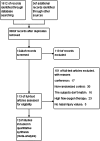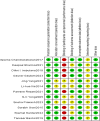Prevention of nasal injury in preterm infants during positive pressure ventilation: a systematic review of interface and dressing selection
- PMID: 40426095
- PMCID: PMC12107769
- DOI: 10.1186/s12887-025-05700-x
Prevention of nasal injury in preterm infants during positive pressure ventilation: a systematic review of interface and dressing selection
Erratum in
-
Correction: Prevention of nasal injury in preterm infants during positive pressure ventilation: a systematic review of interface and dressing selection.BMC Pediatr. 2025 Jun 21;25(1):471. doi: 10.1186/s12887-025-05875-3. BMC Pediatr. 2025. PMID: 40544273 Free PMC article. No abstract available.
Abstract
Objective: To conduct a systematic review and meta-analysis comparing the incidence of nasal injury in preterm infants undergoing continuous positive airway pressure (CPAP) therapy using nasal masks versus nasal prongs, and to explore the potential effects of prophylactic use of hydrocolloid dressings in reducing nasal injury in preterm infants.
Methods: On March 1, 2025, we searched the Web of Science, PubMed, Cochrane, and Embase databases for measures and strategies to prevent nasal injury in preterm infants undergoing positive pressure ventilation, and collected relevant randomized controlled trials. The Cochrane Risk of Bias Assessment Tool was used to evaluate the risk of bias in the literature, and the modified Jadad score was used to assess the quality of the studies. Key information was extracted, including the characteristics of the study subjects, interventions, incidence and severity of nasal injury, and failure rate of positive pressure ventilation.
Results: A total of 12 studies met the inclusion and exclusion criteria, including 1 low-quality study and 11 high-quality studies, with a total sample size of 1,271 participants. Eight studies compared the effects of nasal prongs and nasal masks, with 3 studies investigating the effects of alternating use of nasal prongs and masks. Four studies used hydrocolloid dressings. The results of the meta-analysis showed that the overall incidence of nasal injury was 0.62 (95% CI 0.45-0.87, P = 0.006) in the nasal mask group, 0.95 (95% CI 0.27-3.29, P = 0.093) in the alternating use group, and 0.40 (95% CI 0.30-0.53, P < 0.0001) in the hydrocolloid dressing group.
Conclusion: The incidence of nasal injury was lower in the nasal mask group compared to the nasal prong group. However, the effect of alternating use of nasal masks and prongs on reducing the incidence of nasal injury was not significant. Prophylactic use of hydrocolloid dressings had a significant effect on reducing the incidence of nasal injury in preterm infants. However, the limited number of existing studies and the small sample sizes of the included studies restricted the generalizability of the conclusions. Future research should further optimize the standardization of interventions and conduct multicenter, large-sample randomized controlled trials to promote continuous improvement in clinical nursing practice.
Keywords: Hydrocolloid dressing; Nasal injury; Nasal mask; Nasal prongs; Newborns; Positive pressure ventilation; Preterm infants; Systematic review.
© 2025. The Author(s).
Conflict of interest statement
Declarations. Ethics approval and consent to participate: Not applicable. Consent for publication: Not applicable. Competing interests: The authors declare no competing interests.
Figures










Similar articles
-
Masks versus prongs as interfaces for nasal continuous positive airway pressure in preterm infants.Cochrane Database Syst Rev. 2022 Nov 14;11(11):CD015129. doi: 10.1002/14651858.CD015129. Cochrane Database Syst Rev. 2022. PMID: 36374241 Free PMC article.
-
Nasal intermittent positive pressure ventilation (NIPPV) versus nasal continuous positive airway pressure (NCPAP) for preterm neonates after extubation.Cochrane Database Syst Rev. 2017 Feb 1;2(2):CD003212. doi: 10.1002/14651858.CD003212.pub3. Cochrane Database Syst Rev. 2017. Update in: Cochrane Database Syst Rev. 2023 Jul 27;7:CD003212. doi: 10.1002/14651858.CD003212.pub4. PMID: 28146296 Free PMC article. Updated.
-
Devices and pressure sources for administration of nasal continuous positive airway pressure (NCPAP) in preterm neonates.Cochrane Database Syst Rev. 2008 Jan 23;2008(1):CD002977. doi: 10.1002/14651858.CD002977.pub2. Cochrane Database Syst Rev. 2008. PMID: 18254011 Free PMC article.
-
Prophylactic or very early initiation of continuous positive airway pressure (CPAP) for preterm infants.Cochrane Database Syst Rev. 2021 Oct 18;10(10):CD001243. doi: 10.1002/14651858.CD001243.pub4. Cochrane Database Syst Rev. 2021. PMID: 34661278 Free PMC article.
-
Nasal intermittent positive pressure ventilation (NIPPV) versus nasal continuous positive airway pressure (NCPAP) for apnea of prematurity.Cochrane Database Syst Rev. 2000;(3):CD002272. doi: 10.1002/14651858.CD002272. Cochrane Database Syst Rev. 2000. Update in: Cochrane Database Syst Rev. 2002;(1):CD002272. doi: 10.1002/14651858.CD002272. PMID: 10908544 Updated.
Cited by
-
Correction: Prevention of nasal injury in preterm infants during positive pressure ventilation: a systematic review of interface and dressing selection.BMC Pediatr. 2025 Jun 21;25(1):471. doi: 10.1186/s12887-025-05875-3. BMC Pediatr. 2025. PMID: 40544273 Free PMC article. No abstract available.
References
-
- Massa-Buck B, Rastogi D, Rastogi S. Complications associated with incorrect use of nasal CPAP [J]. J Perinatol. 2023;43(8):975–81. - PubMed
-
- Dai T, Lv L, Liu X, et al. Nasal Pressure Injuries Due to Nasal Continuous Positive Airway Pressure Treatment in Newborns: A Prospective Observational Study [J]. J Wound Ostomy Continence Nurs. 2020;47(1):26–31. - PubMed
-
- Boyar V. Pressure Injuries of the Nose and Columella in Preterm Neonates Receiving Noninvasive Ventilation via a Specialized Nasal Cannula: A Retrospective Comparison Cohort Study [J]. J wound Ostomy Continence Nurs. 2020;47(2):111–6. - PubMed
-
- Rezaei P, Jafari-Mianaei S, Sadeghnia A, et al. Protective Dressings, Injury, and Device Failure in Preterm Infants Receiving Nasal Continuous Positive Airway Pressure: a Randomized Controlled Trial [J]. Adv Skin Wound Care. 2021;34(9):1–6. - PubMed
Publication types
MeSH terms
LinkOut - more resources
Full Text Sources
Miscellaneous

